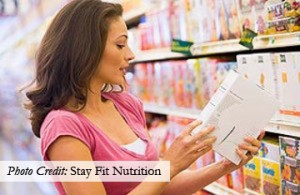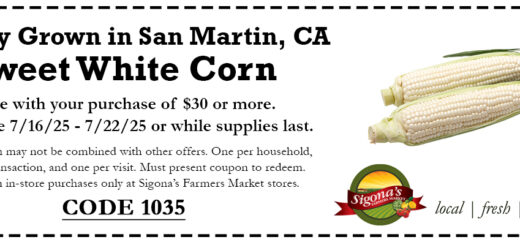New Year, New You: Part 3 | Look at the Label

Geri Wohl, CNC
Better Eating Coach
Written By: Geri Wohl, CNC
www.bettereatingcoach.com
You’ve worked all day and have come home to hungry kids. What do you serve for dinner? Food manufacturers to the rescue, right? Well, if ease is your priority, then yes. If providing nutritious food is paramount, then probably not. Packaged foods were designed to make our lives easier and to be convenient. However, food manufacturers’ primary goal is their bottom line, not our health. They want you to come back for more and keep eating their product to increase their profits, but at the expense of your waistline. As food consumers, we need to look at what is in our food to ensure that we are obtaining good fuel for our bodies and not consuming compounds that adversely affect our metabolism and weight.
My first article in this series, “Eating Well to Lose Weight: Go for the Unrefined,” focused on eating more unrefined food. As much as eating a whole food diet is the goal, sometimes packaged products find their way into our shopping carts. To make better choices, let’s look at the all-important nutrition label since descriptions on the package provide guidance but can be misleading.
 First, let’s start with the front of the package. Do you grab the bag that says “reduced fat” thinking that it is better for you? Or maybe it says that it’s “natural” or “sugar free”. These all imply that they are healthier for you as an enticement to buy that particular product. The nutrition label on the back of the product is more important in helping to be a guide. But, only half of shoppers actually look at it. Here are some common mistakes made and ways to make better purchasing decisions.
First, let’s start with the front of the package. Do you grab the bag that says “reduced fat” thinking that it is better for you? Or maybe it says that it’s “natural” or “sugar free”. These all imply that they are healthier for you as an enticement to buy that particular product. The nutrition label on the back of the product is more important in helping to be a guide. But, only half of shoppers actually look at it. Here are some common mistakes made and ways to make better purchasing decisions.
- Ignoring serving sizes. All food labels will give a number of servings. Sometimes, you eat more than the recommended serving size. If that’s the case, you need to adjust the rest of the numbers accordingly. For example, if a bag of chips contains three servings and you eat the whole bag, remember to triple the calorie count as well as fats, sodium and sugars. You can see how the calories can quickly add up.
- Misunderstanding the terms “reduced”, “light” and “free”. They connote something better for us. Here’s how they are defined. The term “reduced” means that it has 25% less than the norm. While a product with reduced fat may sound beneficial, it is then manufactured with more sugar to compensate, which doesn’t promote health. The term “light” is defined as possessing half the amount as you would normally find. And “free” doesn’t necessarily mean zero. It can mean zero or that a product has less than the 5mg cutoff required by the FDA. This is directly based on serving size. For instance, a product can be labeled as having no trans fat if one serving is below the 5mg threshold. The only way to determine if a product is free of an ingredient is to read the ingredient list.
- Not reading the ingredient list. Looking at the exact ingredients in a product is the best way to know what you will be eating. The higher up on the label, the larger quantity of that ingredient the food contains. Try choosing products with words you recognize. Many processed foods will contain artificial sweeteners, coloring agents and preservatives. If you can’t pronounce the ingredients, it is an indication that you probably don’t want it in your body. In the case of trans fats, they will be listed as “partially hydrogenated”, “fractionated” or just “hydrogenated”. A Harvard nutrition expert has deemed trans fats to be “the biggest food-processing disaster in US history.” Trans fats are associated with increased heart attack risk as well as raising bad LDL cholesterol and triglycerides while reducing our good HDL cholesterol. For more information about trans fats, see my article, “Fearful Fats.”
Keep in mind that packaged foods have been highly processed to give them flavor, texture and taste, all desirable qualities. Yet, this is done at the expense of beneficial nutrients. Typically, many nutrients are removed during processing with only a small subset being added back in. The product is then labelled as “enriched” even though it is net negative on its original nutrients.
Salt, or sodium chloride, is another prime additive in packaged foods. Seventy-five percent of our salt intake is from processed foods. Salt is hidden in many foods such as canned soups and vegetables, sauces like soy and Worcestershire, fast food products and cured or preserved meats like bacon, ham and deli turkey. While sodium is necessary for chemical processes in the body, too much disrupts our finely regulated fluid balance and can result in higher blood pressure and difficulty in muscle contractions and nerve impulses. Even though salt contains no calories, salt makes us retain water and is addictive resulting in consuming more food. The end result is eating more calories and gaining more weight. The recommended sodium intake is 1500mg of sodium per day, which is equivalent to 3/4 teaspoon of salt. However, the average American ingests about 3400mg of salt per day–more than double the recommended amount! Older individuals should consume less to account for their natural increase in blood pressure with aging. On labels, equate salt with any ingredient having sodium as part of its name. An example is MSG, monosodium glutamate, a favorite additive containing salt.
Eating a diet rich in whole foods will eliminate many unwanted calories. To see a sample dinner with unrefined foods, go to my fall recipe page on my website. Cutting down on processed foods can help you achieve your weight loss goals. Here’s to a diet filled with more fresh produce, lean protein and healthy fats!
© Geri Wohl, CNC











